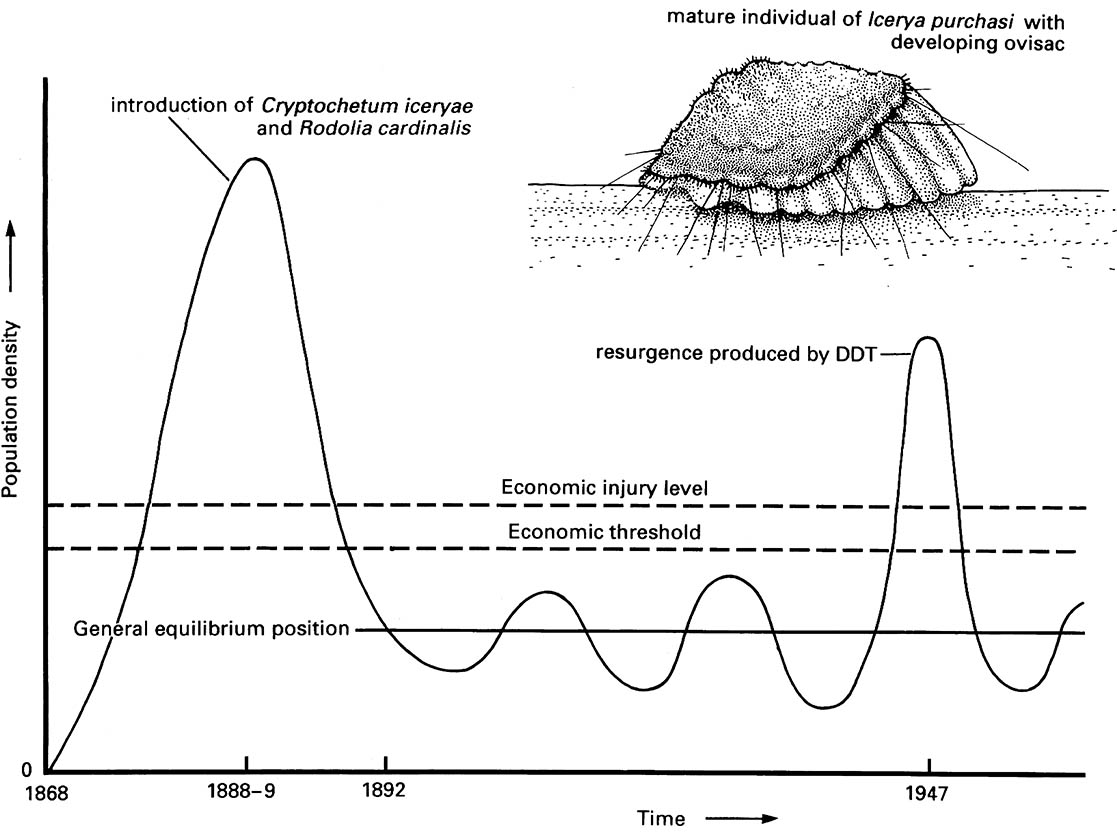Box 16.2. The cottony-cushion scale
An example of a spectacularly successful classical biological control system is the control of infestations of the cottony-cushion scale, Icerya purchasi (Hemiptera: Margarodidae), in Californian citrus orchards from 1889 onwards, as illustrated in the accompanying graph (after Stern et al. 1959). Control has been interrupted only by DDT use, which killed natural enemies and allowed resurgence of cottony-cushion scale.
The hermaphroditic, self-fertilizing adult of this scale insect produces a very characteristic fluted white ovisac (see inset on graph; see also Plate 6.6, facing here), under which several hundred eggs are laid. This mode of reproduction, in which a single immature individual can establish a new infestation, combined with polyphagy and capacity for multivoltinism in warm climates, makes the cottony-cushion scale a potentially serious pest. In Australia, the country of origin of the cottony-cushion scale, populations are kept in check by natural enemies, especially ladybird beetles (Coleoptera: Coccinellidae) and parasitic flies (Diptera: Cryptochetidae).
Cottony-cushion scale was first noticed in the USA in about 1868 on a wattle (Acacia) growing in a park in northern California. By 1886, it was devastating the new and expanding citrus industry in southern California. Initially, the native home of this pest was unknown but correspondence between entomologists in the USA, Australia, and New Zealand identified Australia as the source. The impetus for the introduction of exotic natural enemies came from C.V. Riley, Chief of the Division of Entomology of the US Department of Agriculture. He arranged for A. Koebele to collect natural enemies in Australia and New Zealand from 1888 to 1889 and ship them to D.W. Coquillett for rearing and release in Californian orchards. Koebele obtained many cottony-cushion scales infected with flies of Cryptochetum iceryae and also coccinellids of Rodolia cardinalis, the vedalia ladybird. Mortality during several shipments was high and only about 500 vedalia beetles arrived alive in the USA; these were bred and distributed to all Californian citrus growers with outstanding results. The vedalia beetles ate their way through infestations of cottony-cushion scale, the citrus industry was saved and biological control became popular. The parasitic fly was largely forgotten in these early days of enthusiasm for coccinellid predators. Thousands of flies were imported as a result of Koebele’s collections but establishment from this source is doubtful. Perhaps the major or only source of the present populations of C. iceryae in California was a batch sent in late 1887 by F. Crawford of Adelaide, Australia, to W.G. Klee, the California State Inspector of Fruit Pests, who made releases near San Francisco in early 1888, before Koebele ever visited Australia.
Today, both R. cardinalis and C. iceryae control populations of I. purchasi in California, with the beetle dominant in the hot, dry inland citrus areas and the fly most important in the cooler coastal region; interspecific competition can occur if conditions are suitable for both species. Furthermore, the vedalia beetle, and to a lesser extent the fly, have been introduced successfully into many countries worldwide wherever I. purchasi has become a pest. Both predator and parasitoid have proved to be effective regulators of cottony-cushion scale numbers, presumably owing to their specificity and efficient searching ability, aided by the limited dispersal and aggregative behavior of their target scale insect. Unfortunately, few subsequent biological control systems involving coccinellids have enjoyed the same success.




